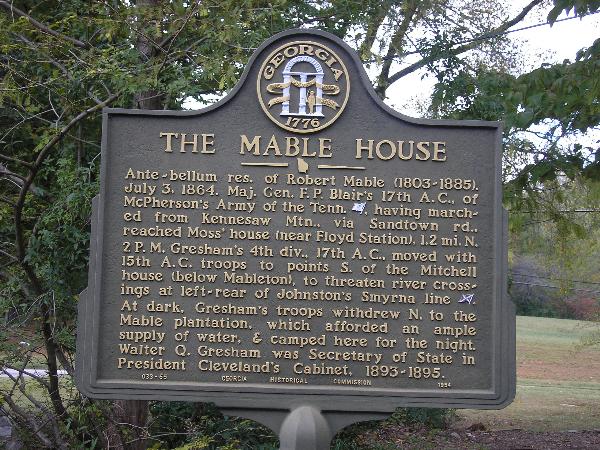
The Mable House, 1843 Plantation House
Posted by:  GA Cacher
GA Cacher
N 33° 49.621 W 084° 34.503
16S E 724417 N 3745620
The historic Mable House, ancestral home of the Mable family for whom Mableton was named, is an example of a plantation plain house constructed in 1843. It sits on the remaining 16 acres of the original 400+ acre farm and includes a kitchen house, corn crib, sweet potato house, storage barn, the family cemetery and the original smokehouse and well. It was used as a hospital during the Civil War and is on the National Register of Historic Places
Waymark Code: WM2GFE
Location: Georgia, United States
Date Posted: 10/30/2007
Views: 76

Robert Mable (1803-1885), a native of Scotland, immigrated to Savannah, Georgia. When he heard of the Georgia Gold Land Lottery of 1832, he purchased 300 acres in the area that became Cobb County. He and his family lived in a log cabin until 1843 when he built a sawmill and began construction of a plantation plain house. Upon moving into the Mable House, the cabin became the location of the first school (private) in Mableton.
The Mable House was used by Federal troops during the Civil War as a field hospital. Wounded soldiers were cared for by Mrs. Mable. This kindness was the basis for the decision to leave the Mable House intact instead of burning the house and outbuildings.
The Georgia Pacific Railroad received land from Robert Mable. When the depot was built on the south side of the tracks west of Church Street, the engineer named the station "Mableton" after the Mable family. Mableton became a city in 1912. Four years later, the citizens voted to unincorporate to avoid the raising of taxes to pay for needed road repairs.
Today the Mable House is on the National Register of Historic Places. The facility is under lease to the Cobb County Board of Commissioners and is operated as part of the Cobb County Parks, Recreation and Cultural Affairs Department.
The historic site comes alive when the Friends of the Mable House host the fall Storytelling Festival, winter Holiday Tour of Homes, school field trips and summer heritage camps.
